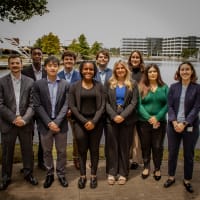The Importance of Diversity in the Workforce for Recruitment Companies
Culture
24 April 2023
Stephanie Taylor

It’s common knowledge to say that diversity is essential in the workplace. But why? What exactly is workplace diversity? It’s the idea that your workplace reflects the makeup of the greater society.
Lovely! But what else?
It’s easy to think that workplace diversity covers demographic groups such as race or gender, but it’s so much broader than that. Workplace diversity is the understanding, accepting, and valuing of the differences between people of different races, ethnicities, genders, ages, religions, disabilities, and sexual orientations, as well as differences in personalities, skill sets, experiences, and knowledge.
This is valuing the work from baby boomers to Gen. Z’ers in the professional fields. Let’s face it, they all work and value different things.
Think of recruitment as marketing. You are essentially marketing open positions at desirable companies to potential candidates. These dream candidates are your target audience. If you are hiring for an engineering position, you need an engineer. But what else? What else about that candidate makes them qualified for this position? What’s their background? What, other than engineering experience, do they bring to the table? What do they value?
There are drastically different generations out there in the global talent pool today. Still, they can all offer a different perspective in the workspace, which is why recruiting diverse candidates is crucial for success. The benefit of a diverse team leads to longevity and retention of valuable employees, which also means fewer resources being spent on training and turnover, so why not get it right the first time? A revolving door in the workplace does not help maintain high office morale and doesn’t look ideal or promising from the outside perspective. As a job seeker, seeing a role advertised several times can raise a red flag about what could be a toxic working environment causing fewer candidates to apply.
Greater diversity also puts the company at a competitive advantage where you will find greater productivity and engagement, which inevitably leads to increased customer service. If your client is part of Gen Y, it might be easier for them to communicate with another person from their generation rather than, for example, Gen Z. And that’s on, period! Or so…. the kids say. The standard of language diversity can also be an excellent asset for a company allowing for communication or expansion across multiple markets. Or perhaps, the candidate looking for a career change offers more, or something completely different, than someone with traditional experience.
By expanding diversity, you also face challenges on how to manage variety. Sure, you have the benefits of innovation and creativity, but you can also meet conflicting perspectives…and that’s okay. Acquired differences, such as skill sets and different experiences, can lead to encouraging, productive and constructive debates with a positive outcome that benefits all involved. Inherent diversity, such as demographic differences like race, gender, and age, can lead to interpersonal conflict requiring more thorough and lengthy communication to resolve an issue and reach a common understanding. When done correctly, these conversations are crucial and can lead to a happier and healthier workplace. A happier workplace equals happier employees.
You can’t have a diverse workplace without hiring a diverse team. So how do you do that? It’s not checking off boxes on a list.
Recruiting and hiring a diverse workforce has challenged many companies, even the tech giants like Google. If you are looking to fill some positions with a diverse pool of candidates, shout it out from the rooftops! Don’t have someone shy away from applying to a job simply because they miss meeting one requirement. That person could possibly offer more than someone who meets every single requirement laid before them. Five years of experience can look like anything, not just a job title at another company. Let’s take the language example from above; a candidate might be missing some requirement on paper, but they happen to speak the language that could communicate a lucrative business deal making them more valuable a candidate.
Also, consider posting jobs across multiple different platforms. Not everyone has a LinkedIn account; if they do, they likely have a basic understanding and are not paying thirty dollars monthly for the premium features. Job postings on Indeed could be oversaturated, but since it’s a free platform, you are open to all applicants, some offering the bare minimum and some who go above and beyond the typical resume and cover letter. It can then get complicated and overwhelming to sort through every applicant to find the perfect match. For instance, if you are looking for female engineers in a historically male-dominated space, try advertising with the Society of Women Engineers or foster relationships with universities to find an exponential candidate from the Gen Z pool who will offer a fresh perspective to a traditional workspace.
Include in a job listing perks that will make the workplace more appealing. There is more that a candidate wants other than a salary and benefits – although that’s very important. Flexibility will attract a more diverse pool of candidates because who doesn’t want a better work/life balance? As mentioned previously, compared to older generations, millennials place more importance on company culture, purpose, and work-life balance. This is why 91% of Patagonia employees say it is a great place to work compared to 59% of employees at a typical U.S.- based company. As well as 93% of employees say they get special and unique benefits and are proud to work there. Plus, they are environmentally conscious and give back to the community. These are all desirable traits that will attract people from all different backgrounds.
For a culturally diverse workplace to function correctly, there must be an effective organization, understanding, and celebration of differences. It must be ingrained and (again) valued within the company culture. Everyone’s unique voice and perspective must be heard to function within an equally diverse market.
As always, it is imperative to be aware of any current legislation. The world around us is constantly changing and evolving, so staying on top of any new rules and regulations is essential to avoid potential litigation.
Remember, a diverse workforce does not mean immediate success. Like anything good and worthwhile in the world, it takes work, time, commitment, and education to implement a truly diverse workplace. The Global Edge is committed to being a key player in creating a more diverse global workforce, and we look forward to continuing to be a part of the change.
What recruiting tricks do you have to help contribute to a more diverse workplace?

